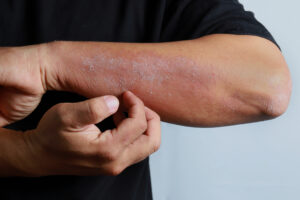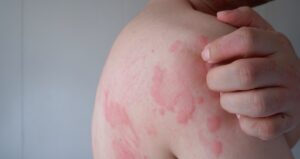Skin Allergy
What Skin Disorders Does NAAC Treat? How We can Help You
We provide care for many different skin issues.
– Determining causes of your skin symptoms, where possible, through clinical evaluation and testing
– Patch testing
– Prevention and non-medication treatment plan/education
– Medication options




Signs & Symptoms of Skin Disorders
Eczema/Atopic Dematitis
Atopic dermatitis, or eczema, is a chronic allergic skin disorder. The rash is characterized by dry, itchy, scaly skin commonly affecting the cheeks, arms, legs, creases behind the ears, and buttocks. The more you scratch the skin, the worse the rash becomes- – and the skin may even become infected.
Eczema can affect approximately 10% of children and most often begins when children are very young (between 2 and 6 months of age). More than 90% of eczema cases have developed by age 5 years old. Up to 50% of children with eczema will eventually develop hay fever or asthma. Although chronic, most children will outgrow eczema by their teen years (though some will have it into adulthood).
Hives & Swelling
Hives (urticaria) and swelling (angioedema) are common medical problems that approximately 20% of people will experience at least once in their lives! Hives occur mostly on the arms, legs, and torso, while swelling tends to occur around the lips, eyes, hands, feet, and genitals and can involve the tongue and throat.
Ultimately, hives and swelling are considered variations of the same problem. However, finding the cause of hives and swelling is difficult and about half of the time the cause is unknown and called “idiopathic.”
It is very rare for chronic hives and swelling to be caused by something external such as foods or environment. Physicians call it “acute” if the problem is new or been present for 6 weeks or less and “chronic” if the problem has persisted longer.
Contact Dermatitis
Contact dermatitis is a red, itchy rash caused by direct contact with a substance. 80% of contact dermatitis are caused by irritants, such as soaps, detergents, and other chemicals. The remaining 20% of contact dermatitis is allergic contact dermatitis, which are immune reactions to specific substances, such as nickel, poison ivy, fragrances, and dyes.
To assure that you recognize and have a management plan for your allergy symptoms and any severe reactions, it’s important to be under the care of an allergy specialist.